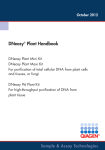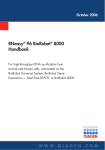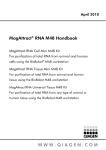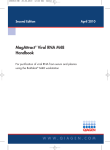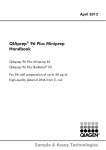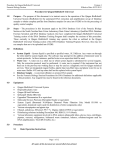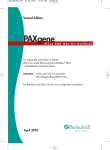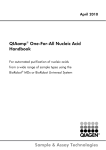Download Methods for DNA extraction
Transcript
Manual & Automated Methods for DNA extraction from the Buccal DNA Collector 1. Manual Organic Extraction (1+ samples) Use a 4.7mm punch from the tip of collector. 1. Placed punched sample into a 1.5ml tube. 2. Add 400µl of extraction buffer (10mM Tris-HCl (pH 8), 10mM EDTA, disodium salt (pH 8), 100mM NaCl, 2% SDS) and 10µl of Proteinase k(20mg/ul). 3. Vortex and incubate overnight at 56°C. 4. Add 400 µl of PCI (phenol/chloroform/isoamyl alcohol) and invert tube to mix the layers. Centrifuge at 5,000 x g for 10 minutes. Carefully transfer the upper, aqueous layer into a new 1.5ml tube. 5. Repeat step 4. 6. Add 400 µl of CI (chloroform:isoamyl alcohol 24:1). Invert tube to mix the layers and spin for 1 min at 5,000 x g. 7. Carefully transfer the upper layer into a new 1.5ml tube. Add 800µl ice cold 100% ethanol and place in -20°C freezer for 2h. 8. Centrifuge at 10,000 x g for 20 minutes then discard the supernatant. 9. Add 1ml of 70% ethanol and centrifuge at 10,000 x g for 20 minutes then discard the supernatant. 10. Dry the pellet at room temperature for 1-3h. 11. Add 20µl of TE buffer (pH 8) and incubate sample at 56°C for 15 minutes to dissolve pellet. This is a list of some of the extraction methods available. There are many other extraction methods that may be used with Bode products. Each laboratory must choose there own methods and perform proper validation. Bode would be happy to help answer questions regarding Bode products. Please contact the reagent manufacturer’s with any questions regarding those products. Manual extraction using silica-membrane technology 2. Qiagen QIAamp DNA Investigator Kit (1+ samples) Follow protocol Isolation of Total DNA from FTA and Guthrie Cards using a 4.7mm punch from the tip of the collector: Things to do before starting ■ Equilibrate Buffer ATE or distilled water for elution to room temperature (15–25°C). ■ Set a thermomixer or heated orbital incubator to 56°C for use in step 4 and (optional) step 16, and a second thermomixer or heated orbital incubator to 70°C for use in step 7. If thermomixers or heated orbital incubators are not available, heating blocks or water baths can be used instead. ■ Ensure that Buffers have been prepared according to the instructions in the Qiagen manual. Procedure 1. Place punched sample into a 1.5 ml microcentrifuge tube. 2. Add 280 μl Buffer ATL. 3. Add 20 μl proteinase K and mix thoroughly by vortexing. 4. Place the 1.5 ml tube in a thermomixer or heated orbital incubator, and incubate at 56°C with shaking at 900 rpm for 1 h. If using a heating block or water bath, vortex the tube for 10 s every 10 min to improve lysis. 5. Briefly centrifuge the 1.5 ml tube to remove drops from the inside of the lid. 6. Add 300 μl Buffer AL, close the lid, and mix by pulse-vortexing for 10 s. To ensure efficient lysis, it is essential that the sample and Buffer AL are thoroughly mixed to yield a homogeneous solution. A white precipitate may form when Buffer AL is added to Buffer ATL. The precipitate does not interfere with the QIAamp procedure and will dissolve during the heat incubation in step 7. Note: we recommend adding 1µl carrier RNA for every extracted sample to Buffer AL. Note that carrier RNA does not dissolve in Buffer AL. It must first be dissolved in Buffer ATE and then added to Buffer AL. 7. Place the 1.5 ml tube in a thermal mixer or heated orbital incubator, and incubate at 70°C with shaking at 900 rpm for 10 min. If using a heating block or water bath, vortex the tube for 10 s every 3 min. 8. Briefly centrifuge the 1.5 ml tube to remove drops from the inside of the lid. 9. Add 150 μl ethanol (96–100%), close the lid, and mix thoroughly by pulse vortexing for 15 s. To ensure efficient binding in step 11, it is essential that the sample and ethanol are thoroughly mixed to yield a homogeneous solution. 10. Briefly centrifuge the 1.5 ml tube to remove drops from the inside of the lid. 11. Carefully transfer the entire lysate from step 10 to the QIAamp MinElute column (in a 2 ml collection tube) without wetting the rim, close the lid, and centrifuge at 6000 x g (8000 rpm) for 1 min. Place the QIAamp MinElute column in a clean 2 ml collection tube, and discard the collection tube containing the flow-through. If the lysate has not completely passed through the membrane after centrifugation, centrifuge again at a higher speed until the QIAamp MinElute column is empty. 12. Carefully open the QIAamp MinElute column and add 500 μl Buffer AW1 without wetting the rim. Close the lid and centrifuge at 6000 x g (8000 rpm) for 1 min. Place the QIAamp MinElute column in a clean 2 ml collection tube, and discard the collection tube containing the flow-through. 13. Carefully open the QIAamp MinElute column and add 700 μl Buffer AW2 without wetting the rim. Close the lid and centrifuge at 6000 x g (8000 rpm) for 1 min. Place the QIAamp MinElute column in a clean 2 ml collection tube, and discard the collection tube containing the flow-through. This is a list of some of the extraction methods available. There are many other extraction methods that may be used with Bode products. Each laboratory must choose there own methods and perform proper validation. Bode would be happy to help answer questions regarding Bode products. Please contact the reagent manufacturer’s with any questions regarding those products. Contact between the QIAamp MinElute column and the flow-through should be avoided. Some centrifuge rotors may vibrate upon deceleration, resulting in the flow-through, which contains ethanol, coming into contact with the QIAamp MinElute column. Take care when removing the QIAamp MinElute column and collection tube from the rotor, so that flow-through does not come into contact with the QIAamp MinElute column. 14. Carefully open the QIAamp MinElute column, and add 700 μl of ethanol (96–100%) without wetting the rim. Close the cap and centrifuge at 6000 x g (8000 rpm) for 1 min. Place the QIAamp MinElute column in a clean 2 ml collection tube, and discard the collection tube containing the flow-through. 15. Centrifuge at full speed (20,000 x g; 14,000 rpm) for 3 min to dry the membrane completely. This step is necessary, since ethanol carryover into the eluate may interfere with some downstream applications. 16. Place the QIAamp MinElute column in a clean 1.5 ml microcentrifuge tube and discard the collection tube containing the flow-through. Carefully open the lid of the QIAamp MinElute column, and incubate at room temperature (15–25°C) for 10 min or at 56°C for 3 min. 17. Apply 20–100 μl Buffer ATE or distilled water to the center of the membrane. Important: Ensure that Buffer ATE or distilled water is equilibrated to room temperature (15–25°C). If using small elution volumes (<50 μl), dispense Buffer ATE or distilled water onto the center of the membrane to ensure complete elution of bound DNA. QIAamp MinElute columns provide flexibility in the choice of elution volume. Choose a volume according to the requirements of the downstream application. Elution with small volumes increases the final DNA concentration in the eluate significantly, but reduces the overall DNA yield. Remember that the volume of eluate will be up to 5 μl less than the volume of elution solution applied to the column. 18. Close the lid and incubate at room temperature (15–25°C) for 1 min. Centrifuge at full speed (20,000 x g; 14,000 rpm) for 1 min. Incubating the QIAamp MinElute column loaded with Buffer ATE or water for 5 min at room temperature before centrifugation generally increases DNA yield. This is a list of some of the extraction methods available. There are many other extraction methods that may be used with Bode products. Each laboratory must choose there own methods and perform proper validation. Bode would be happy to help answer questions regarding Bode products. Please contact the reagent manufacturer’s with any questions regarding those products. 3. Qiagen QIAamp 96 DNA Blood Kit (1-96 samples) Follow protocol Isolation of genomic DNA from dried blood spots using the QIAamp® 96 DNA Blood Kit using a 4.7mm punch from the tip of the collector. Additionally, purchase Buffer ATL. Important point before starting ■ Perform all centrifugation steps at room temperature (15–25°C). Things to do before starting ■ Equilibrate Buffer ATE or distilled water for elution to room temperature (15–25°C). ■ Set a thermomixer or heated orbital incubator to 56°C for use in step 4 and (optional) step 16, and a second thermomixer or heated orbital incubator to 70°C for use in step 7. If thermomixers or heated orbital incubators are not available, heating blocks or water baths can be used instead. ■ Ensure that buffers have been prepared according to the instructions in the Qiagen manual. Procedure 1. Place punched samples into individual wells of a round well block. 2. Add 200 μl Buffer ATL. 3. Add 20 μl proteinase K and mix thoroughly by vortexing. 4. Place the block in a thermomixer or heated orbital incubator, and incubate at 56°C with shaking at 900 rpm for 1 h. If using a heating block or water bath, vortex the tube for 10 s every 10 min to improve lysis. 5. Add 200 μl Buffer AL to each sample, taking care not to wet the rims of the wells. Seal the wells using the caps for blocks and tubes provided. Note: Use only the caps for blocks and tubes, since using AirPore tape or caps for elution microtubes at this stage of the procedure will lead to cross-contamination. Ensure that the wells are properly sealed to avoid leaks during shaking. 6. Mix thoroughly by shaking vigorously for 15 s. For efficient lysis, it is essential that the samples and Buffer AL are mixed immediately and thoroughly to yield a homogeneous solution. Hold the round-well block with both hands and shake up and down vigorously. Note: Simply inverting the round-well block several times is not sufficient to initiate efficient lysis. Similarly, vortexing or placing the plate on a shaker is not adequate. 7. Centrifuge briefly at 3000 rpm to collect any solution from the caps. Allow centrifuge to reach 3000 rpm, then stop the centrifuge. Note: When processing 96 samples using a single round-well block, the centrifuge must be accurately balanced. 8. Incubate at 70°C for at least 10 min in an incubator or oven. Longer incubation times have no effect on the quality of the purified DNA. Potentially infectious agents can be inactivated by incubating the sample at 95°C for an additional 15 min after cell lysis. However, extended incubation at high temperatures may lead to DNA degradation. Note: Placing a weight on top of the round-well block will prevent the lids popping off during incubation. 9. Centrifuge briefly at 3000 rpm to collect any lysate from the caps. Allow centrifuge to reach 3000 rpm, then stop the centrifuge. 10. Remove the caps and add 200 μl ethanol (96–100%) to each well. 11. Seal the wells using new caps for blocks and tubes. Shake vigorously for 15 s. 12. Centrifuge briefly at 3000 rpm to collect any solution from the caps. This is a list of some of the extraction methods available. There are many other extraction methods that may be used with Bode products. Each laboratory must choose there own methods and perform proper validation. Bode would be happy to help answer questions regarding Bode products. Please contact the reagent manufacturer’s with any questions regarding those products. Allow centrifuge speed to reach 3000 rpm, then stop the centrifuge. 13. Place QIAamp 96 plate on top of an S-block. Mark the plate for later identification. 14. Carefully apply the mixture from step 8 to the QIAamp 96 plate. Take care not to wet the rims of the wells to avoid aerosol formation during centrifugation. Note: If extended, narrow pipet tips (such as Matrix cat. no. 8255) are not used, lowering pipet tips to the bottoms of the wells may cause overflow and cross contamination due to the large sample volumes. We recommend removing one strip at a time and drawing up samples as soon as the pipet tips contact the samples. Repeat until all the samples have been applied to the QIAamp 96 plate. 15. Seal the QIAamp 96 plate with an AirPore tape sheet. Load the S-block and QIAamp 96 plate onto the carrier, then place it in the rotor bucket. Centrifuge at 6000 rpm for 4 min. 16. Remove the tape. Carefully add 500 μl Buffer AW1 to each well. 17. Seal the QIAamp 96 plate with a new AirPore tape sheet. Centrifuge at 6000 rpm for 2 min. 18. Remove the tape. Carefully add 500 μl Buffer AW2 to each well. 19. Centrifuge at 6000 rpm for 15 min. The heat generated during centrifugation ensures evaporation of residual ethanol in the sample (from Buffer AW2) that might otherwise inhibit downstream reactions. OR Centrifuge at 6000 rpm for 3 min. After centrifugation, incubate the plate in an oven at 70°C for 10 min. This step allows evaporation of residual ethanol while reducing laboratory noise. 20. Place the QIAamp 96 plate on top of a rack of elution microtubes (provided). 21. To elute DNA, add 200 μl Buffer AE or distilled water, equilibrated to room temperature, to each well using a multichannel pipet. Seal the QIAamp 96 plate with a new AirPore tape sheet and incubate for 1 min at room temperature. Centrifuge at 6000 rpm for 4 min. Seal the wells of the microtubes for storage using the caps for elution microtubes provided. DNA yields can be increased by incubating the QIAamp 96 plate loaded with Buffer AE for 5 min at room temperature before centrifugation. A second elution step with a further 200 μl Buffer AE increases yields by up to 20%. Elution with volumes of less than 200 μl significantly increases the final DNA concentration, but slightly reduces the overall yield. For samples containing less than 1 μg DNA, elution in 50 μl Buffer AE or water is recommended. Eluting with2 x 100 μl instead of 1 x 200 μl does not increase elution efficiency. For long-term storage of DNA, eluting in Buffer AE and storing at –20°C is recommended, since DNA stored in water is subject to acid hydrolysis. This is a list of some of the extraction methods available. There are many other extraction methods that may be used with Bode products. Each laboratory must choose there own methods and perform proper validation. Bode would be happy to help answer questions regarding Bode products. Please contact the reagent manufacturer’s with any questions regarding those products. Automated extraction using silica-membrane technology 4. BioRobot Universal System (1-96 samples) with the QIAamp® Investigator BioRobot® Kit Follow the protocol Pretreatment for Dried Blood using a 4.7mm punch from the tip of collector. Important point before starting ■ Undiluted Proteinase k is required Things to do before starting ■ Set a shaker-incubator to 56°C ■ Ensure that all reagents have been prepared according to the Qiagen manual Procedure 1. Placed punched sample into either a 2 ml tube or the well of an S-Block. 2. Add 280 μl Buffer ATL and 20 μl undiluted proteinase K. Mix by vortexing (if using tubes) or by pipetting up and down several times (if using an S-Block). 3. Place the tubes or S-Block onto a shaker–incubator at 56°C for at least 1 h with shaking at 900 rpm. Note: Be sure to cap the tubes or to cover the S-Block with adhesive tape. After incubation, perform a brief centrifugation to collect liquid at the bottom of the tubes or the S-Block. 4. Transfer 300 μl of each lysate to a new S-Block. 5. Make sure that the BioRobot Universal System is switched on. The power switch is located on the lower right of the BioRobot Universal System front panel. 6. Switch on the computer and monitor. 7. Launch the QIAsoft 5 Operating System. The QIAsoft 5 software can be started from the Microsoft® Windows® “Start” menu, where it is located under Programs/QIAsoft 5/QIAsoft 5. 8. Enter your user name and password in the “Login” dialog box, and click “OK” to access the QIAsoft 5 software. 9. Select the QIAamp DNA Blood Card UNIV protocol from the protocol selection box in the “Execute” environment toolbar. 10. Click to start the protocol. The QIAsoft 5 software will now take you through the remaining steps required to set up the BioRobot Universal System for your selected protocol. Follow the steps detailed in each protocol message before continuing. This is a list of some of the extraction methods available. There are many other extraction methods that may be used with Bode products. Each laboratory must choose there own methods and perform proper validation. Bode would be happy to help answer questions regarding Bode products. Please contact the reagent manufacturer’s with any questions regarding those products. Manual extraction using magnetic particle technology 5. Promega DNA IQ System (1+ samples) Follow the protocol DNA Isolation from Stains and Buccal Swabs using a 4.7mm punch from the tip of collector. Things to do before starting ■ Set a heat block to 70°C ■ Set a heat block to 65°C ■ Ensure that all reagents have been prepared according to the Promega manual 1. Placed punched sample into a 1.5ml tube. 2. Add 150µl of Lysis Buffer. 3. Incubate tube on heat block set to70°C for 30 minutes. 4. Remove the tube from the heat source, and transfer the prepared Lysis Buffer and sample to a DNA IQ™ Spin Basket seated in a 1.5ml microcentrifuge tube. Centrifuge at room temperature for 2 minutes at maximum speed in a microcentrifuge. Remove the spin basket. 5. Vortex the stock resin bottle for 10 seconds at high speed or until resin is thoroughly mixed. Add 7μl of DNA IQ™ Resin to the sample. Keep the stock resin resuspended while dispensing to obtain uniform results. 6. Vortex the sample/Lysis Buffer/resin mixture for 3 seconds at high speed. Incubate at room temperature for 5 minutes. Vortex mixture for 3 seconds once every minute during this 5-minute incubation. 7. Vortex tube for 2 seconds at high speed. Place tube in the magnetic stand. Separation will occur instantly. Note: If resin does not form a distinct pellet on the side of the tube, vortex the tube and quickly place back in the stand. 8. Carefully remove and discard all of the solution without disturbing the resin pellet on the side of the tube. Note: If some resin is drawn up in tip, gently expel resin back into tube to allow re-separation. 9. Add 100μl of prepared Lysis Buffer. Remove the tube from the magnetic stand, and vortex for 2 seconds at high speed. 10. Return tube to the magnetic stand, and discard all Lysis Buffer. 11. Add 100μl of prepared 1X Wash Buffer. Remove tube from the magnetic stand, and vortex for 2 seconds at high speed. 12. Return tube to the magnetic stand, and discard all Wash Buffer. 13. Repeat Steps 11 and 12 two more times for a total of three washes. Be sure that all of the solution has been removed after the last wash. 14. With the tube in the magnetic stand and the lid open, air-dry the resin for 5 minutes. Do not dry for more than 20 minutes, as this may inhibit removal of DNA. 15. Add 100μl of Elution Buffer. 16. Close the lid, and vortex the tube for 2 seconds at high speed. Incubate the tube at 65°C for 5 minutes. 17. Remove the tube from the heat source, and vortex for 2 seconds at high speed. Immediately place the tube on the magnetic stand. Tubes must remain hot until placed in the magnetic stand or yield will decrease. 18. Carefully transfer the DNA-containing solution to a container of choice. This is a list of some of the extraction methods available. There are many other extraction methods that may be used with Bode products. Each laboratory must choose there own methods and perform proper validation. Bode would be happy to help answer questions regarding Bode products. Please contact the reagent manufacturer’s with any questions regarding those products. Automated extraction using magnetic particle technology 6. Qiagen EZ1 Advanced (1-6 samples) or Qiagen EZ1 Advanced XL (1-14 samples) Use the EZ1 DNA Investigator Kit and follow the protocol Pretreatment for Dried Blood using a 4.7mm punch from the tip of collector. Things to do before starting ■ Dilute Buffer G2 with distilled water using a ratio of 1:1 ■ Set a shaker-incubator to 56°C 1. Placed punched sample into a 2 ml tube. 2. Add 190 μl diluted Buffer G2 to the sample. Note: Prepare diluted Buffer G2 as described in “Things to do before starting”. 3. Add 10 μl proteinase K, and mix thoroughly by vortexing for 10 s. 4. Place tube in a thermomixer or heated orbital incubator, and incubate at 56°C with shaking at 900 rpm for 1 h. If using a heating block or water bath, vortex the tube for 10 s every 10 min to improve lysis. 5. Insert the DNA Investigator Card completely into the EZ1 Card slot 6. Switch on the EZ1 instrument. 7. Press “START” to start protocol setup. 8. Press “2” (for Trace TD protocol). 9. Follow the onscreen instructions to load reagents and start protocol. This is a list of some of the extraction methods available. There are many other extraction methods that may be used with Bode products. Each laboratory must choose there own methods and perform proper validation. Bode would be happy to help answer questions regarding Bode products. Please contact the reagent manufacturer’s with any questions regarding those products. 7. Qiagen Biosprint 96 Workstation (1-96 samples) Use the Biosprint 96 DNA Blood Kit and follow protocol Purification of DNA from Dried Blood Spots using a 4.7mm punch from the tip of collector. Things to do before starting ■ Prepare buffer reagents, wash plates and elution plate according to the Qiagen manual ■ Set a shaker-incubator to 56°C 1. Place punched samples into individual wells of a round well block. 2. Add 200 μl Buffer ATL. 3. Add 20 μl proteinase K and mix thoroughly by vortexing. 4. Place the block in a thermomixer or heated orbital incubator, and incubate at 56°C with shaking at 900 rpm for 1 h. If using a heating block or water bath, vortex the tube for 10 s every 10 min to improve lysis. 5. Add 200 μl Buffer AL to each sample, taking care not to wet the rims of the wells. Seal the wells using the caps for blocks. 6. Vortex for 10 s. 7. Centrifuge briefly at 3000 rpm to collect any solution from the caps. Allow centrifuge to reach 3000 rpm, then stop the centrifuge. Note: When processing 96 samples using a single round-well block, the centrifuge must be accurately balanced. 8. Incubate at 70°C for 10 min in an incubator or oven. Note: Placing a weight on top of the round-well block will prevent the lids popping off during incubation. 9. Centrifuge briefly at 3000 rpm to collect any lysate from the caps. Allow centrifuge to reach 3000 rpm, then stop the centrifuge. 10. Remove the caps and add 200 μl ethanol (96–100%) to each well. 11. Add 30 μl MagAttract Suspension G. Note: Before adding MagAttract Suspension G, ensure that it is fully resuspended. Vortex for 3 min before using for the first time, and for 1 min before subsequent uses. 12. Switch on the BioSprint 96 at the power switch. 13. Slide open the front door of the protective cover. 14. Select the protocol “BS96 DNA Blood 250”. Press “Start” to start the protocol run. 15. The LCD displays a message asking you to load slot 8 of the worktable with the 96-rod cover. After loading slot 8, press “Start.” The worktable rotates and a new message appears, asking you to load slot 7 with the elution plate. Load slot 7 and press “Start” again. Continue this process of pressing “Start” and loading a particular slot until all slots are loaded. 16. Check that the protective cover is correctly installed: it should fit exactly into the body of the BioSprint 96. Slide the door shut to protect samples from contamination. See the BioSprint 96 User Manual for safety information. 13. Press “Start” to start sample processing. This is a list of some of the extraction methods available. There are many other extraction methods that may be used with Bode products. Each laboratory must choose there own methods and perform proper validation. Bode would be happy to help answer questions regarding Bode products. Please contact the reagent manufacturer’s with any questions regarding those products.









